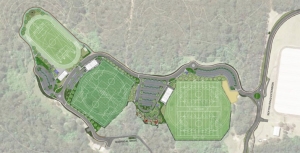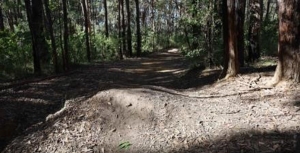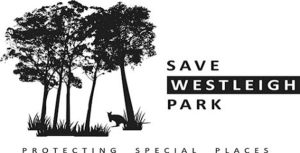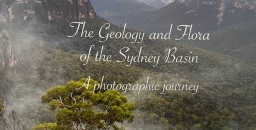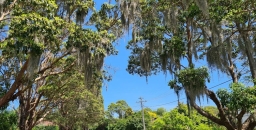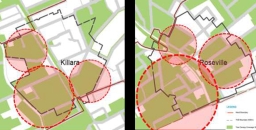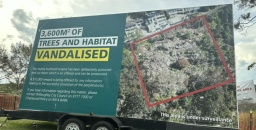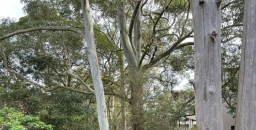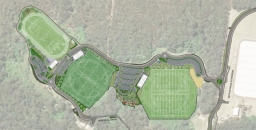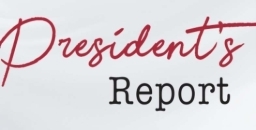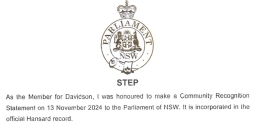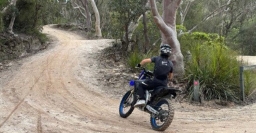Displaying items by tag: Westleigh Park
Westleigh Park development final planning stage completed
The process for the development of Westleigh Park has been long and slow since the land was purchased from Sydney Water in 2016. We wrote about this project in Issues 217 and 219 of STEP Matters. Since 2021 Hornsby Council has been developing plans for a major sporting complex and seeking consultation along the way. The major issue from the environment point of view is the mountain bike tracks that were built illegally by local enthusiasts through the bushland including critically endangered Sydney Turpentine-Ironbark Forest and endangered Duffy Forest.
Much consultation and many workshops have been held particularly about the bike trails. This evolved into a draft master plan and plan of management that were exhibited during 2023. These were finalised and on 13 September 2023 council resolved to provide owner's consent for the lodgement of a development application (DA/975/2023) for Westleigh Park.
Funding withdrawal
Then there was a major hiccup. In 2018, Hornsby was given $40 million for the Westleigh Park project under the Stronger Communities Grant process. These grants were criticised by the auditor-general because of the dominance of awards to Liberal electorates. Since then only $4 million of the grant money has been used. In June the now Labor government ordered council to repay $36 million because they had not demonstrated sufficient progress on the project. Council can keep the interest earned on the money. Nevertheless, council is proceeding.
Stages of development
The project has been divided into three stages (1a, 1b and 2). There is funding for stage 1a with a completion date of mid-2026. Further work will be undertaken as funds become available. Funding is available under a separate grant for construction of mountain bike trails.
Stage 1a
Includes the southern sports platform, mountain bike trails, carparks 3 and 4 the Sefton Road extension – west section and the shared pathway to Ruddock Park.
Stage 1b
Includes the Sefton Road extension – north and east sections around the reservoir.
Stage 2
Has uncertain timing and covers the centre and northern sports platforms, carparks 1 and 2 and Warrigal Drive upgrades.
Sydney North Planning Panel final stage
The final approval stage was completed on 4 December when a Sydney North Planning Panel hearing was held. The purpose of the meeting was to give interested people the opportunity to speak directly to the planning panel before a decision is made. The panel took only four days to determine that the project can go ahead.
Major concerns
- The high level of development of the project and the resulting number of visitors travelling along roads to the end of a ridge surrounded by Berowra Valley National Park and the Dog Pound Creek biobanking site.
- The continuation of bike tracks in endangered ecological communities. Council made a referral to the Commonwealth Department of Climate Change, Energy, the Environment and Water asking whether the developments in the bushland that contains endangered ecological communities and threatened flora and fauna needed to be assessed as a controlled action under the EPBC Act. Sadly, this was determined as not necessary which means that the proposed development does not require further assessment or conditions under the EPBC Act.
- The area of bike trails close to an aboriginal rock shelter and the decision to move a scar tree.
- Impact on wildlife of 30 m high floodlighting in use until 10 pm.
- Risk of synthetic turf in bushfire prone area.
- Allowance for use of e-bikes that can be almost of fast as motorbikes.
- Management of the site to prevent control behaviours, damage to wildlife and vegetation.
Recent submissions: planning and Westleigh Park
The Upper House of the NSW parliament has been conducting an inquiry into how the planning system can be improved so that people, threatened species and the built environment are protected from the impact of climate change. Sue Higginson from The Greens is chairing the inquiry. The terms of reference were broad and provided an opportunity for individuals, local councils and community groups to comment using local examples of the long list of inadequacies of the system and the resulting environmental destruction. They make interesting reading!
The development application for Westleigh Park was open for submissions until 20 November. STEP’s criticisms of this large project have not been addressed so our submission drew largely from previous ones. Most of the more detailed ecological reports have many inadequacies so we consider that the development application should not be submitted to the Planning Panel until the missing details are covered. The basic problems that we have written about many times remain, namely the mountain bike trails, the use of synthetic turf and the serious and irreversible impacts on Sydney Turpentine Ironbark Forest.
Westleigh Park development
In Issues 217 and 219 of STEP Matters there was some information about the proposals for development by Hornsby Council of the land known as Westleigh Park.
The Save Westleigh Park group has been engaging with the local community explaining the draft plans that have been put out for consultation. Very few locals are aware of this significant development. It is very disappointing that council has not even put up signs in the local shopping centre to alert the locals. This development will have major impacts as there is currently only one road providing access to this major sporting complex with three fields. Does council expect people to be constantly on social media looking for local news?
The draft Master Plan and Plan of Management were approved for exhibition by councillors at the 8 March meeting. Four weeks was provided for submissions with closing date of 9 April for the draft Master Plan and 23 April for the Plan of Management.
Mountain bike trails to remain in the endangered forests
The biggest bone of contention has always been the illegal mountain bike trails in the large bushland area that totals 26 ha. This bushland includes areas of critically endangered Sydney Turpentine Ironbark Forest (STIF) and endangered Duffys Forest, totalling 9 ha plus several threatened species in other areas. The trails were built by the mountain bikers while the land was owned by Sydney Water and have been expanded since. They have named the complex network zigzagging through the bushland as H2O MTB Trails.
In 2021 council exhibited a preliminary master plan that proposed that most of the trails in the endangered forest be removed or relocated to the edges. Trails in the other bushland would remain and be upgraded to conform to industry standards. This caused an outraged reaction from the mountain bike community.
Council held a series of workshops to try to establish a consensus between the opposing groups of mountain bikers and local community and conservation groups. This was never going to happen. We waited with bated breath to see the final proposals that Council would come up with.
No doubt there was much lobbying going on behind the scenes. The conservationists group, now called Save Westleigh Park, were horrified to see that council was proposing to retain some of the trails and even build some new ones in the endangered forest areas. A specialist trail building company had been brought in to advise on a network that would be a ‘good experience’ and cover a range of abilities from beginner to advanced.
The total length of trails would be reduced from 9.5 to 7.3 km. The trails in STIF would be reduced from 2.45 to 0.96 km and in Duffys Forest from 1.9 to 1.5 km. However some of these trails would be new so more damage to the bushland, including the endangered forests, would be incurred.
The continuation of trails in the endangered ecological communities goes against all the principles of conservation. Council claims they are observing the Biodiversity Conservation Act hierarchy of avoid, minimise and mitigate, but they will have to resort to the last stage and try to find offsets for the loss of integrity of the forests. The STIF is critically endangered which means the forest is on the brink of extinction. There are only small areas left so suitable offsets are not available and the net effect will be a loss of healthy STIF.
Not only will the trails remain in the forest but the general public will be excluded from their use. The only consolation is a walking track that is only 150 m long plus a shared path around the boundary between the bushland and the sporting fields.
The Master Plan also does not specify when and how council will close down the trails that are to be removed and undertake the rehabilitation to undo the damage already done.
Risks to endangered ecological communities
STEP’s submission on the Master Plan focussed on the risks posed by the building and use of bikes through endangered ecological communities that threaten their survival. These include:
- disruption of pollination
- soil compaction that damages fungal diversity and spore dispersal
- edge effects that change growing conditions such as light, humidity and wind
- introduction of pathogens
By allowing these trails to continue council is evading its responsibilities under the Biodiversity Conservation Act to protect these forests.
Other issues
There are other concerns about the Master Plan many of them related to the plans to squeeze three sporting fields into the cleared areas.
The draft Plan suggests that the middle sporting field that is designed for soccer could be synthetic grass. This is highly inappropriate for an area so close to the bushland.
It is also proposed to build a link trail through the Dog Pound Creek biobanking site to the Hornsby Quarry site. This area is another critically endangered ecological community and a biobanking site. It must be protected from pathogens that could be introduced by the movement of bicycles. There is already evidence of Phytophera infestation. It is intended to close this link from use by walkers so they will lose the experience of a spectacular area of Blue Gum Diatreme Forest.
The whole development is large enough to cater for regional needs, not just local needs. Hornsby Council has received a large grant ($40 million) but this is not sufficient to cover the huge cost of the project. Rate payers will be covering much of the cost.
One major cost is the need to remove the contaminants such as asbestos and heavy metals that have arisen from the use of the site as a tip and fire-fighting training ground. These are to be localised and buried under concrete. Will this be effective? The fields will then need to be levelled which involves building up the south-west corner by 8.5 m.
Funding is not available for the whole project so it will be done in stages. The removal of the mountain bike trails in the endangered ecological communities and rehabilitation of the weed infested bushland should be a priority.
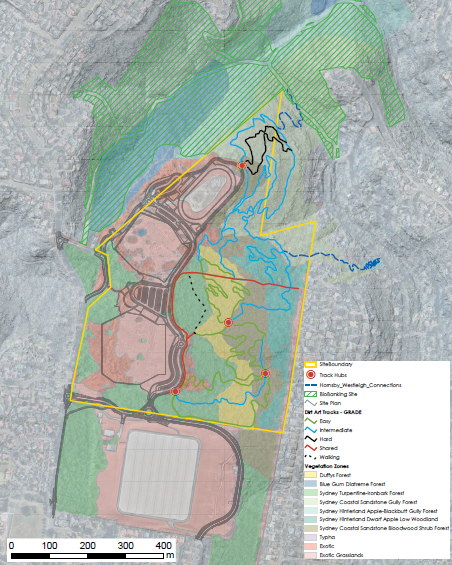
Save Westleigh Park – a new community alliance
I have to admit I didn’t know anything about the location of Westleigh until the Westleigh Park Master Plan development was announced by Hornsby Council. Westleigh is a small suburb on a ridge surrounded by Berowra Valley National Park and bushland along Waitara Creek and the biobanking site of Dog Pound Creek. The only road into Westleigh is Quarter Sessions Road with access via busy Duffy Avenue.
For the past two years Hornsby Council has been developing a plan for the development of the land known as Westleigh Park. This area of 36 ha was bought by council from Sydney Water in 2016. The water reservoir next to the park is still managed by Sydney Water. Currently council land has:
- a 26 ha area of bushland that is riddled with unauthorised mountain bike tracks – see STEP Matters Issue 217 for a story about what should be happening here
- a cleared area of 10 ha that was a land fill site and is predominately tufted grasses and unmaintained Kikuyu and weeds
- a Rural Fire Service building on the northern side so that land has been used for training
There has been community consultation and now it is expected that a final draft of the master plan will go before council soon.
The plan is for the creation of an extensive sporting field complex on the cleared land including three sporting fields, small areas for passive recreation and road access and parking areas. One of the fields may be synthetic which is inappropriate for an area so close to bushland. Preparation of the land for this development will be a major expensive exercise owing to contamination, its topography and need to control run-off into the nearby bushland.
Major traffic issue
One essential prerequisite for the creation of the park is improved road access. Council is expecting to get approval from Sydney Water to extend Sefton Road from Chilvers Road around the reservoir to Quarter Sessions Road. This will increase traffic significantly along Sefton Road through the industrial area of Thornleigh and the quiet suburban areas of Westleigh. A traffic study has forecast an extra 1,500 car movements a day at the Sefton and Chilvers Road intersection.
One possible solution for the problems the development will cause is to reduce the number of sporting fields and make the road only open for emergency access.
New alliance of community groups
A group of ten local community groups (including Westleigh Progress Association, Friends of Berowra Valley, Protecting Your Suburban Environment and STEP) have formed a new alliance called Save Westleigh Park to keep both residents and businesses updated on council's current ill-planned schemes, as well as the significant impacts the development will have.
Council's community engagement with Westleigh residents has been poor. A recent council-run public meeting about the traffic impacts was only attended by 11 residents with seven apologies, as the meeting was by council invitation only. Yet obviously the traffic impacts are much wider than just those residents. Click here for the latest traffic study.
Action
Make your concerns about this proposed enormous regional sporting complex and its significant lasting impacts known through the traffic petition and the save Westleigh Park petition.

